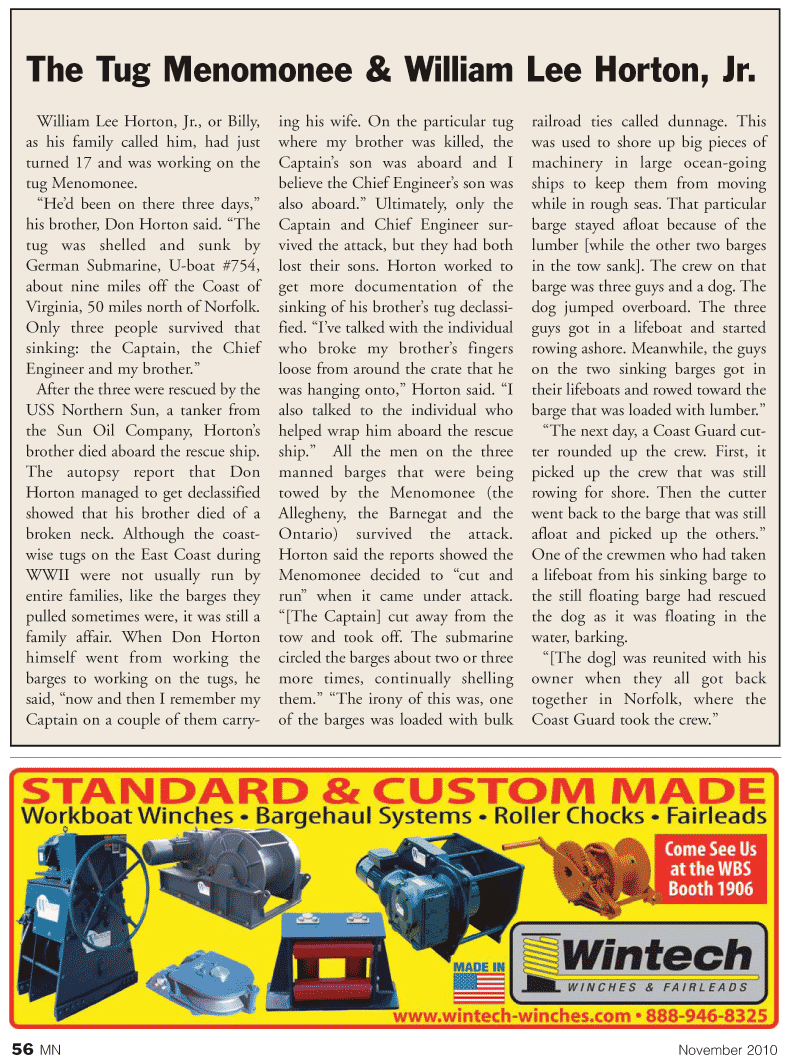
Page 56: of Marine News Magazine (November 2010)
Workboat Annual
Read this page in Pdf, Flash or Html5 edition of November 2010 Marine News Magazine
56 MN November 2010
William Lee Horton, Jr., or Billy, as his family called him, had just turned 17 and was working on the tug Menomonee. “He’d been on there three days,” his brother, Don Horton said. “The tug was shelled and sunk by
German Submarine, U-boat #754, about nine miles off the Coast of
Virginia, 50 miles north of Norfolk.
Only three people survived that sinking: the Captain, the Chief
Engineer and my brother.”
After the three were rescued by the
USS Northern Sun, a tanker from the Sun Oil Company, Horton’s brother died aboard the rescue ship.
The autopsy report that Don
Horton managed to get declassified showed that his brother died of a broken neck. Although the coast- wise tugs on the East Coast during
WWII were not usually run by entire families, like the barges they pulled sometimes were, it was still a family affair. When Don Horton himself went from working the barges to working on the tugs, he said, “now and then I remember my
Captain on a couple of them carry- ing his wife. On the particular tug where my brother was killed, the
Captain’s son was aboard and I believe the Chief Engineer’s son was also aboard.” Ultimately, only the
Captain and Chief Engineer sur- vived the attack, but they had both lost their sons. Horton worked to get more documentation of the sinking of his brother’s tug declassi- fied. “I’ve talked with the individual who broke my brother’s fingers loose from around the crate that he was hanging onto,” Horton said. “I also talked to the individual who helped wrap him aboard the rescue ship.” All the men on the three manned barges that were being towed by the Menomonee (the
Allegheny, the Barnegat and the
Ontario) survived the attack.
Horton said the reports showed the
Menomonee decided to “cut and run” when it came under attack. “[The Captain] cut away from the tow and took off. The submarine circled the barges about two or three more times, continually shelling them.” “The irony of this was, one of the barges was loaded with bulk railroad ties called dunnage. This was used to shore up big pieces of machinery in large ocean-going ships to keep them from moving while in rough seas. That particular barge stayed afloat because of the lumber [while the other two barges in the tow sank]. The crew on that barge was three guys and a dog. The dog jumped overboard. The three guys got in a lifeboat and started rowing ashore. Meanwhile, the guys on the two sinking barges got in their lifeboats and rowed toward the barge that was loaded with lumber.” “The next day, a Coast Guard cut- ter rounded up the crew. First, it picked up the crew that was still rowing for shore. Then the cutter went back to the barge that was still afloat and picked up the others.”
One of the crewmen who had taken a lifeboat from his sinking barge to the still floating barge had rescued the dog as it was floating in the water, barking. “[The dog] was reunited with his owner when they all got back together in Norfolk, where the
Coast Guard took the crew.”
The Tug Menomonee & William Lee Horton, Jr.

 55
55

 57
57
